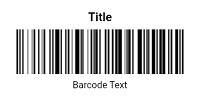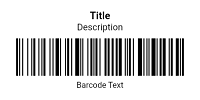The EAN-2, or European Article Number-2, is a barcode symbology used to encode a two-digit supplemental code. It is often found alongside larger barcodes such as EAN-13 or UPC-A, providing additional information typically used in periodicals and books to encode the issue number or publication date.
Developed as part of the EAN/UPC barcode system, the EAN-2 was introduced to supplement main barcodes with additional data. This system was designed to be compatible with international standards and facilitate global commerce, particularly in the retail and publishing industries.
Technical Specifications
The EAN-2 barcode encodes two numeric digits, ranging from 00 to 99. It consists of five bars and spaces for each digit, with varying widths representing each number. The barcode is prefixed by a unique start code and uses a modulo-4 checksum for error detection.
Structure:
- Start Code: Indicates the beginning of the barcode.
- Data Characters: Two digits encoded using a specific pattern of bars and spaces.
- Checksum: Ensures data integrity by verifying the encoded digits.
Checksum Calculation
The checksum for EAN-2 is calculated using a modulo-4 algorithm. The two digits are weighted and summed, and the result is divided by 4. The remainder determines the checksum pattern used in the barcode.
- Assign weights to the digits based on their positions (weighting patterns vary).
- Sum the weighted digits.
- Divide the sum by 4 and use the remainder to select the checksum pattern.
Advantages and Disadvantages
The EAN-2 barcode offers several advantages, notably its ability to supplement the main barcode with additional information. By encoding extra data in a compact, two-digit format, it provides a way to convey more detailed information without requiring a larger barcode. Its small size allows it to be easily integrated alongside primary barcodes, making efficient use of space and maintaining the overall layout and readability of the barcode system.
However, there are limitations to the EAN-2 barcode. Its data capacity is restricted to just two digits, which limits the extent of additional information it can provide. Furthermore, EAN-2 cannot function independently; it must always be used in conjunction with a main barcode. This dependency reduces its utility as a standalone solution and confines its application to systems where a primary barcode is already in place.
EAN-2 Applications
EAN-2 is primarily used in the publishing industry to encode supplemental information. Common applications include:
- Magazines and Periodicals: Encodes the issue number, helping retailers and distributors manage and track different editions.
- Books: Supplements the main barcode with additional data such as the date of publication, making inventory management more efficient.
- Retail: Provides extra information for products that require more specific data points beyond the main barcode, aiding in better categorization and tracking.
Comparison with Other Barcode Symbologies
In comparison to other barcode symbologies, like UPC-A, which is prevalent in North America and encodes 12 digits, EAN-2's use is more niche. UPC-A does not include the supplemental information that EAN-2 provides, and while it has a similar structure, its applications are often limited to basic product identification without additional data layers.
When comparing EAN-2 with Code 128, another versatile symbology, notable differences emerge. Code 128 supports a wider range of characters and can encode both letters and numbers, making it more suitable for complex data encoding requirements. EAN-2, by contrast, is strictly numeric and used in conjunction with EAN-13 for specific purposes. Code 128 also offers a higher data density, meaning it can store more information in a smaller space compared to EAN-2. For applications requiring extensive data encoding or varied character sets, Code 128 would be preferred. However, for situations needing a supplementary numeric code alongside a primary barcode, EAN-2's simplicity and direct integration with EAN-13 make it a practical choice.


